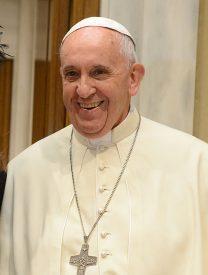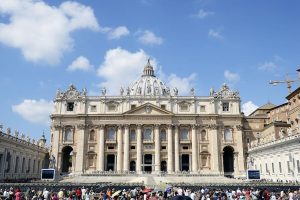The Roman Catholics
 Pope Francis in 2015 © Wikimedia Commons
Pope Francis in 2015 © Wikimedia Commons
 Saint Peter's Basilica in Rome (Italy)
Saint Peter's Basilica in Rome (Italy)
They are Christians who belong to the apostolic Roman Catholic Church, under the authority of the Pope, but also to the united East Churches in Rome.
It is also called the Latin Church in the Middle-East, as opposed to the Eastern Churches which not use Latin in their liturgies.
After the East-West schism, the Catholic Church summoned councils, often said ecumenical, but they only assembled Catholic bishops.
The last three were as follows:
–Council of Trente (1545-55 and 1559-63):
Doctrinal and disciplinary reforms (Conter-Reformation and Catholic Reformation);
– Vatican Council (1870):
Primacy of the pope and papal infallibility concerning the dogma;
– Vatican II Council (1962-65):
Reform and modernization of the Catholic Church. Withdrawal of reciprocal anathema between the Catholic and Orthodox Churches. A secretariat to promote Christian unity was created. Protestant observers were invited.
 Filiations of Christian faiths © Musée Virtuel du Protestantisme
Filiations of Christian faiths © Musée Virtuel du Protestantisme
Légende
A : Chrétiens d’origine nestorienne A’ : Catholiques d’origine nestorienne
B : Chrétiens d’origine monophysite B’ : Catholiques d’origine monophysite
C : Catholiques d’origine orthodoxe D : Catholiques antérieurs au schisme d’Orient
E : Chrétiens d’origine catholique malabare F : Catholiques d’origine malankare
G : Catholiques du patriarcat latin de Jérusalem
The united East Churches in Rome are as follows:
– the Maronite Church (5th century) and the Malabar Church (5th century) never broke off from Rome;
– Churches issued from Nestorian, Monophysite and Orthodox Churches who joined Rome in their histories: that is why they were often called Uniates. They preserved their liturgy and their own structure and were under the authority of a patriarch or of a leader of the Church:
– the Chaldean Church;
– the Syro-Malabar Catholic Church;
– the Syriac Catholic Church;
– the Armenian Catholic Church;
– the Coptic Catholic Church;
– the Ethiopian Catholic Church;
– the Ukranian Greek-Catholic Church;
– the Romanian Greek-Catholic Church;
– the Greek-Melkite Catholic Church.
The Old-Catholics
They originated from Roman Catholicism, but broke away from Rome.
The first Old-Catholic Church was created in Utrecht (the Netherlands) in 1724, after a dispute with the pope about the election of the bishop in Utrecht. 150 years later it federated with the Catholics who refused the dogmas of the papal primacy and infallibility claimed by the Vatican council in 1870.
Nowadays they can be found mostly in Switzerland (Christian-Catholic Church), in Germany, in Austria and in the Czech Republic. They moved closer to the Anglicans with whom they are in inter-Communion.